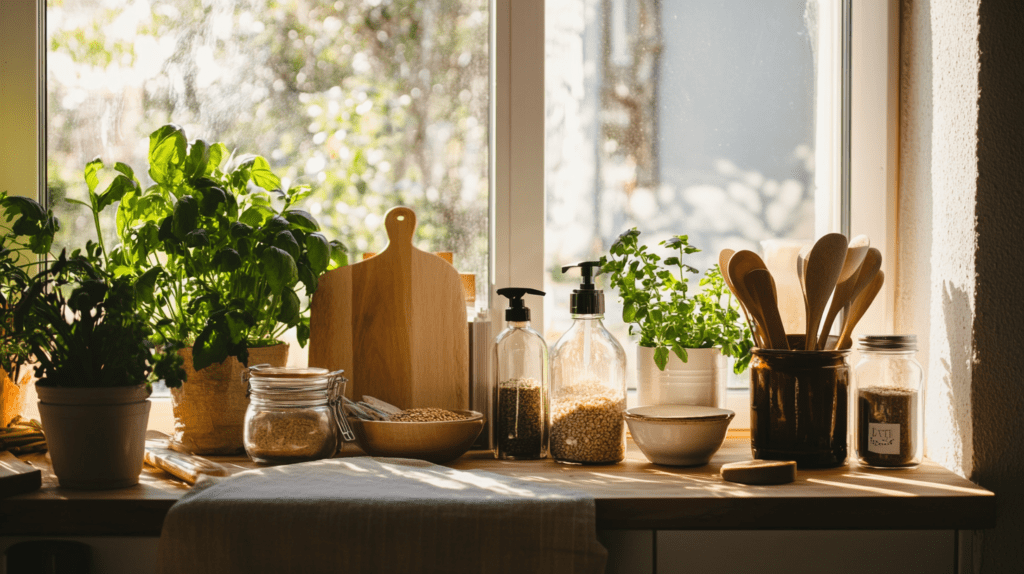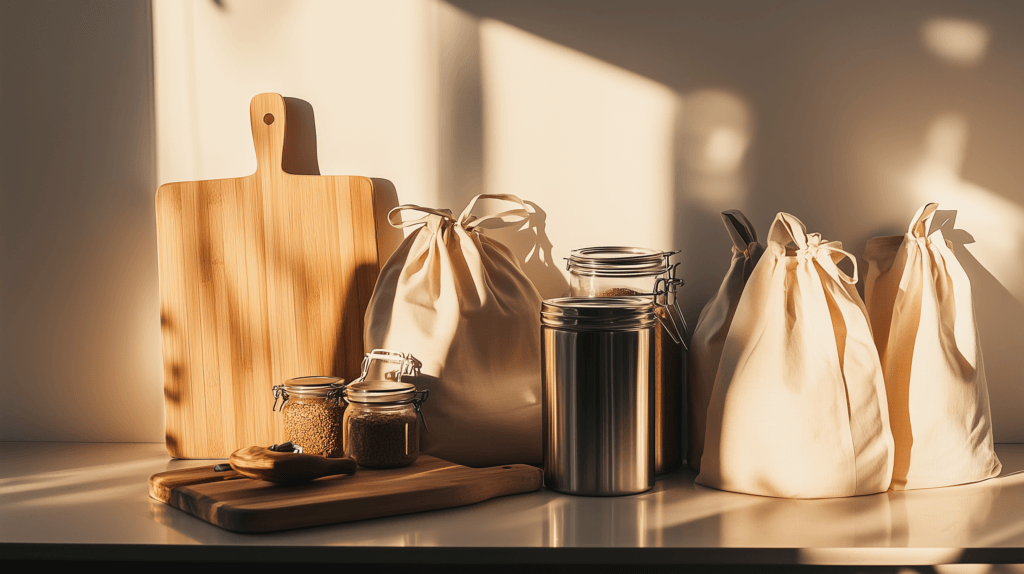This post may contain affiliate links, including those from Amazon Associates. If you make a purchase through these links, I may earn a commission at no additional cost to you. Learn more about our affiliate policy.
Most people don’t realize that the bathroom is one of the most toxic spaces in the home.
Between synthetic fragrances, harsh cleaning chemicals, and plastic-heavy personal care products, it’s an area where hidden toxins can build up quickly.
Every time we step into the shower, wash our hands, or freshen the air, we may unknowingly be exposing ourselves to endocrine disruptors, volatile organic compounds (VOCs), and other harmful substances that linger in the air and absorb into our skin.
I remember when I first started making the switch to a non-toxic home, the bathroom felt like the most overwhelming place to start.
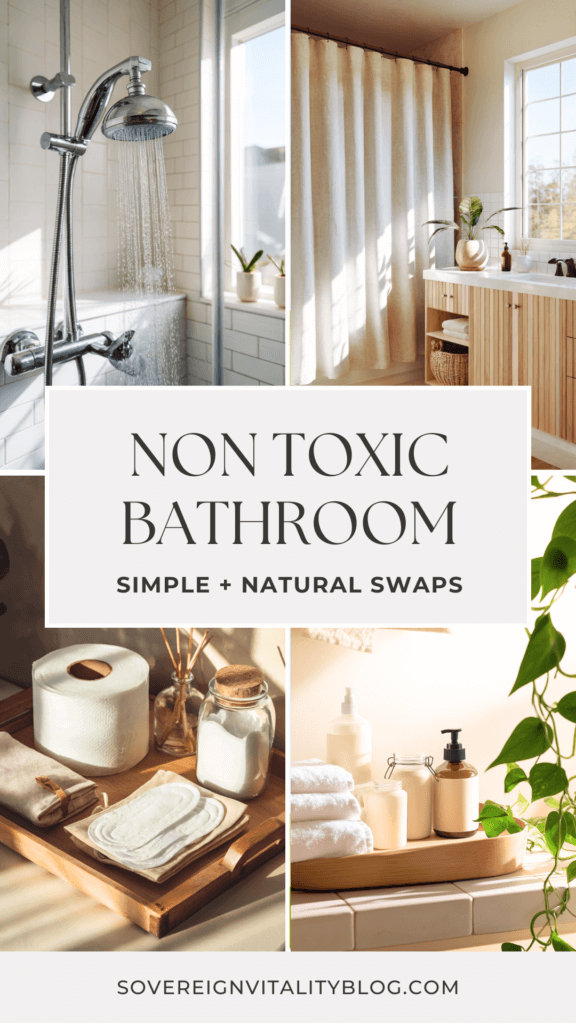
There were so many products embedded in my daily routine: soaps, shampoos, air fresheners, toilet paper. But once I began replacing them with simpler, natural alternatives one by one, I noticed an immediate difference. My skin was less irritated, the air felt fresher, and I wasn’t constantly breathing in synthetic chemicals.
Detoxing your bathroom doesn’t have to be complicated. By making a few simple swaps, you can significantly reduce exposure to toxins while creating a space that’s healthier for both you and the environment. In this guide, we’ll walk through seven easy steps to transition to non-toxic alternatives so you can enjoy a bathroom that’s truly clean.
1. Ditch Synthetic Fragrances
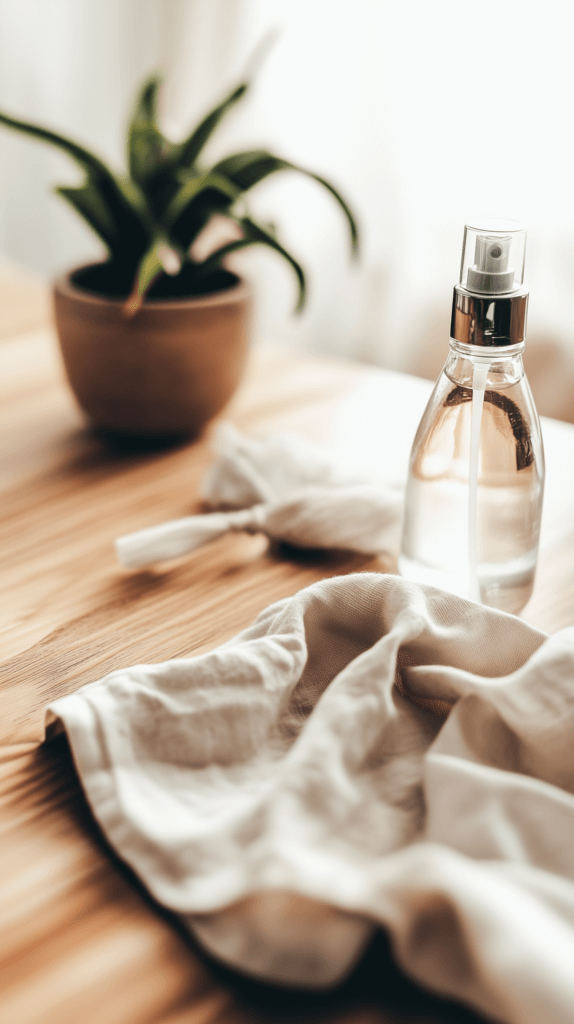
One of the biggest sources of hidden toxins in the bathroom is synthetic fragrances. Air fresheners, scented candles, plug-ins, and aerosol sprays may seem like they’re making the space feel cleaner, but in reality, they are polluting indoor air with chemicals that can disrupt hormones, irritate the lungs, and trigger allergies.
I used to love the smell of those store-bought “fresh linen” sprays and vanilla-scented candles, thinking they made my bathroom smell clean.
But once I learned that most commercial air fresheners contain phthalates, formaldehyde, and benzene, I couldn’t ignore the potential health risks. These chemicals don’t just disappear after a quick spritz. They linger in the air, attach to dust particles, and are inhaled with every breath.
Why Synthetic Fragrances Are Harmful
Many commercial air fresheners and candles are made with petroleum-based chemicals, artificial fragrances, and undisclosed “parfum” ingredients, which often contain:
- Phthalates – Used to make scents last longer but known to interfere with hormone function.
- Formaldehyde – A carcinogen found in some aerosol sprays and plug-ins.
- Benzene & Toluene – VOCs that contribute to indoor air pollution and respiratory issues.
Since bathrooms are usually small, enclosed spaces with limited airflow, these toxins become even more concentrated, making ventilation and non-toxic alternatives essential for cleaner air.
Safer Alternatives for a Naturally Fresh Bathroom
The best way to freshen your bathroom without exposing yourself to chemicals is to replace synthetic fragrances with natural, plant-based options that actually purify the air rather than pollute it.
- Essential Oil Diffusers – Instead of artificial plug-ins, use an ultrasonic diffuser with pure essential oils like lavender, eucalyptus, or citrus for a clean, fresh scent.
- Beeswax Candles – Unlike paraffin candles, which release soot and toxins, beeswax candles naturally purify the air by emitting negative ions.
- DIY Air Fresheners – Making your own air freshening sprays is an easy, non-toxic alternative that lets you control exactly what’s in them.
2. Switch to Non-Toxic Cleaning Products
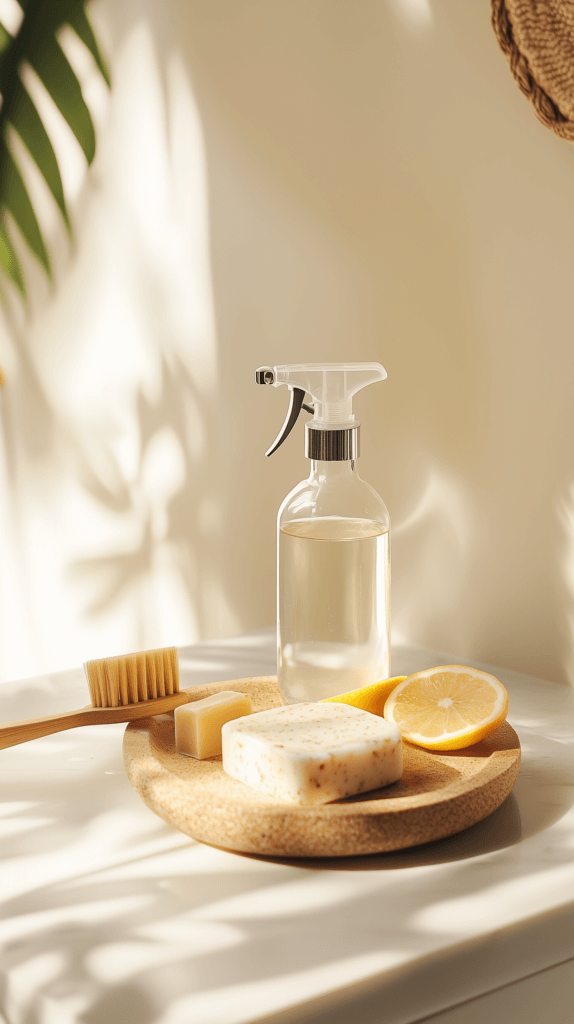
Most conventional bathroom cleaners are loaded with harsh chemicals that can impact both indoor air quality and long-term health.
Many popular disinfecting sprays, toilet bowl cleaners, and mildew removers contain bleach, ammonia, phthalates, and formaldehyde, which release toxic fumes and leave behind residue that lingers on surfaces and in the air.
For years, I thought the overpowering scent of chemical cleaners meant my bathroom was truly clean. But after switching to natural cleaning alternatives, I realized that I didn’t need those harsh fumes to get a fresh, sparkling space.
Easy DIY Alternatives for a Safer Clean
One of the best ways to detox your bathroom is to make your own DIY non-toxic cleaning products using simple, natural ingredients like vinegar, baking soda, and essential oils. Not only are these alternatives effective and budget-friendly, but they also eliminate the need for synthetic chemicals altogether.
- All-Purpose Bathroom Cleaner – A simple mix of vinegar, water, and essential oils can clean mirrors, countertops, and even shower tiles without leaving behind harmful residues.
- Toilet Bowl Scrub – Baking soda and castile soap make a powerful, non-toxic toilet cleaner that removes stains and deodorizes naturally.
- Mold and Mildew Spray – Tea tree oil mixed with water is an effective mold and mildew fighter without the need for harsh chemicals.
If you want step-by-step instructions for making these and other homemade solutions, check out my DIY non-toxic cleaning guide for simple, effective recipes that work just as well as store-bought options.
Recommended Store-Bought Non-Toxic Cleaners
If DIY isn’t your thing or you’re looking for a quick swap, there are plenty of great non-toxic cleaning brands that get the job done without exposing your home to unnecessary toxins. Some of the best options include:
Dr. Bronner’s Sal Suds Biodegradable Cleaner is a powerful yet gentle all-purpose cleaner made with plant-based surfactants and essential oils. Effective in hard or soft water, it’s perfect for home, laundry, and dishes—offering a non-toxic, eco-friendly cleaning solution.
Bon Ami Powder Cleanser is a non-toxic, eco-friendly cleaner that gently polishes and removes grime from various surfaces without harsh chemicals. Hypoallergenic and fragrance-free, it’s a trusted, sustainable choice for a naturally clean home.

3. Upgrade Your Personal Care Products
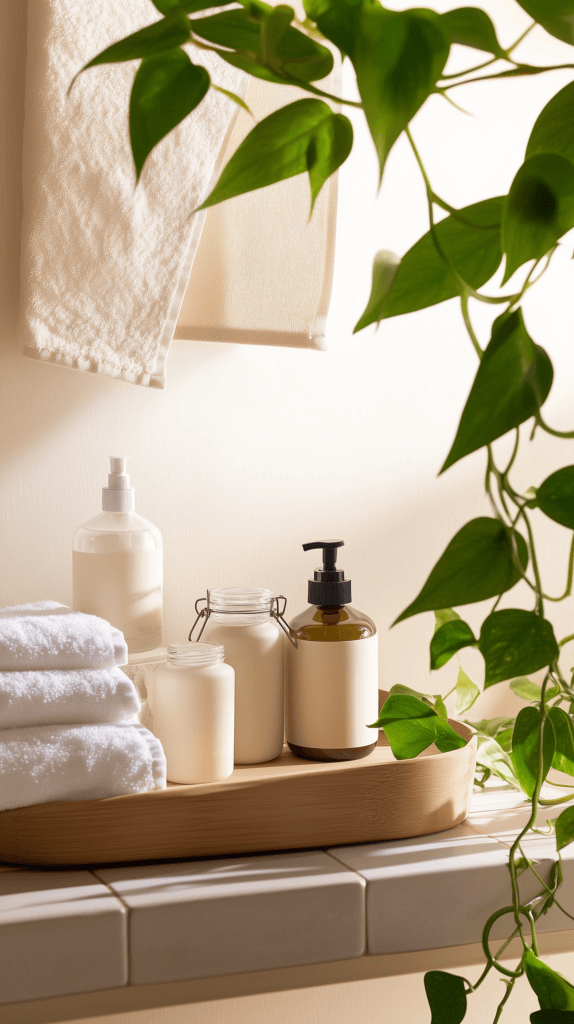
Many people don’t realize that shampoos, soaps, and body washes can be major sources of toxic exposure in the bathroom. These products are used daily and absorbed directly into the skin, yet most conventional options are filled with parabens, sulfates, and synthetic fragrances that can disrupt hormones, irritate the skin, and contribute to long-term health concerns.
I used to love the way my body wash smelled, but after learning that the “fragrance” on the label could contain hundreds of undisclosed chemicals, I started paying closer attention. After switching to cleaner, naturally scented alternatives, I noticed my skin wasn’t as dry, and I wasn’t constantly exposing myself to questionable ingredients.
Harmful Ingredients to Avoid
Most commercial personal care products contain a cocktail of synthetic additives that may make them lather well and smell good but don’t do your body any favors. Here are some of the most common toxins found in everyday bathroom products:
- Parabens – Preservatives used in shampoos, body washes, and lotions that mimic estrogen and disrupt hormone balance.
- Sulfates (SLS and SLES) – Foaming agents that strip natural oils from skin and hair, often leading to dryness and irritation.
- Artificial Fragrances – A blend of undisclosed chemicals that can trigger allergies, skin sensitivities, and endocrine disruption.
- Triclosan – An antibacterial agent found in some soaps and body washes, linked to hormone disruption and antibiotic resistance.
If you’re looking to detox your bathroom, one of the best places to start is by swapping out these products for safer alternatives.
How to Choose Natural Alternatives
Finding truly non-toxic personal care products can feel overwhelming at first, but the key is to simplify the ingredient list. Instead of focusing on marketing claims like “natural” or “clean,” look for products with short, recognizable ingredient lists that contain nourishing, plant-based ingredients.
Here’s what to look for:
- Shampoos and Body Washes – Opt for formulas that use botanical extracts, coconut-based cleansers, and essential oils instead of sulfates and artificial fragrances.
- Soaps and Hand Washes – Choose castile soap, goat’s milk soap, or unscented plant-based options to avoid triclosan and harsh preservatives.
- Lotions and Moisturizers – Look for organic oils like jojoba, shea butter, and aloe vera, which hydrate naturally without parabens or petroleum-based ingredients.
Acure Ultra Hydrating Shampoo is a 100% vegan, sulfate-free formula infused with argan and pumpkin seed oils to deeply nourish, hydrate, and strengthen hair. Designed for vitality and moisture, it enhances shine while supporting a clean, natural lifestyle.

Dr. Bronner’s Pure Castile Liquid Soap is a nourishing, non-toxic body wash made with organic, fair-trade ingredients. Infused with soothing lavender, it gently cleanses without synthetic additives—perfect for a minimalist, eco-friendly bathroom and a truly clean self-care ritual.

ATTITUDE Body Lotion is an EWG-verified, plant-based moisturizer designed for deep hydration without greasiness. Infused with revitalizing orange leaves, it nourishes dry skin while remaining vegan, cruelty-free, and dermatologically tested—perfect for an intentional, clean skincare ritual.

4. Use a Healthier Shower Curtain
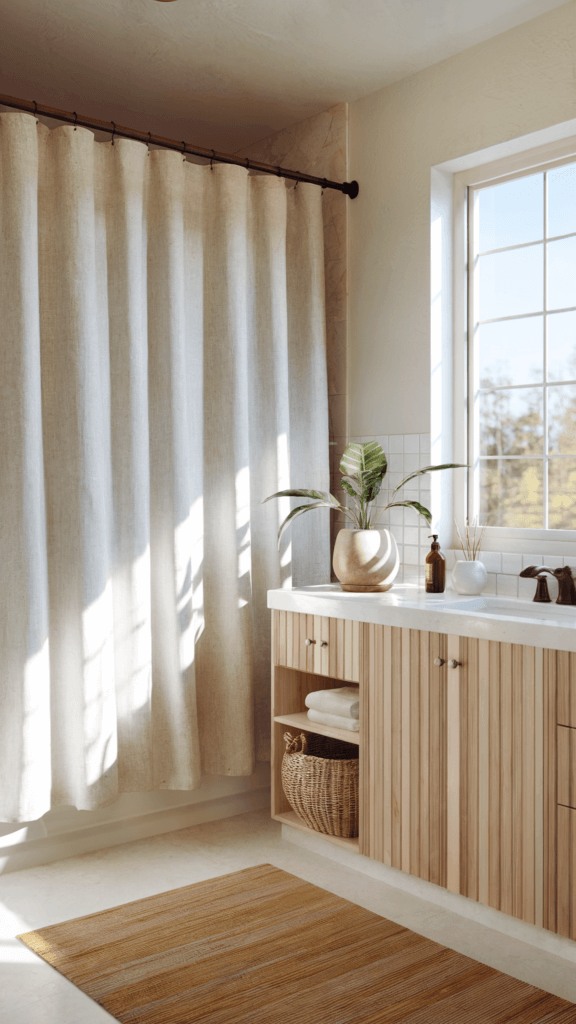
Most conventional shower curtains are made from PVC (polyvinyl chloride), one of the most toxic plastics in the home. When new, PVC shower curtains off-gas harmful chemicals like phthalates, dioxins, and VOCs, which can linger in the air and contribute to respiratory irritation, hormone disruption, and poor indoor air quality.
The worst part? This off-gassing doesn’t just happen when the curtain is new, it continues over time, especially in warm, humid bathroom environments.
Better Alternatives for a Non-Toxic Bathroom
The good news is that there are safer, non-toxic shower curtain materials that perform just as well without releasing harmful chemicals into your home:
- Organic Cotton or Linen Shower Curtains – Completely natural, breathable, and free from plastic-based materials. These can be washed regularly and are the best option for a toxin-free bathroom.
- PEVA or EVA Shower Liners – Unlike PVC, PEVA (polyethylene vinyl acetate) and EVA (ethylene vinyl acetate) are chlorine-free and do not release the same toxic fumes. They are waterproof, easy to clean, and a much safer alternative to standard plastic liners.
5. Choose Safer Toilet Paper and Feminine Products
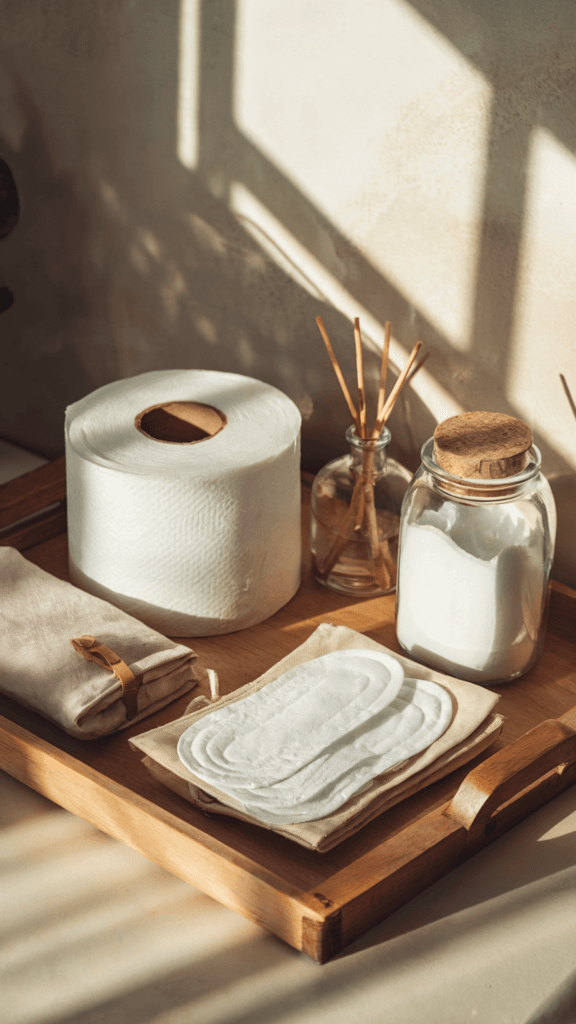
Many people don’t realize that toilet paper and menstrual products can be a hidden source of toxic exposure in the bathroom. Conventional toilet paper is bleached with chlorine, which creates dioxins, a group of harmful byproducts linked to hormone disruption and environmental pollution.
Similarly, most tampons and pads contain synthetic fibers, artificial fragrances, and pesticide-treated cotton, all of which come into direct contact with the most absorbent areas of the body.
Better Alternatives for Toilet Paper
Instead of using chlorine-bleached toilet paper, look for:
- Unbleached toilet paper – Free from harsh bleaching agents, reducing exposure to dioxins.
- Bamboo toilet paper – A sustainable, naturally soft option that requires fewer resources to produce.
- Recycled toilet paper – Made from post-consumer waste, reducing environmental impact and limiting chemical processing.
Betterway Bamboo Toilet Paper offers a sustainable, ultra-soft 3-ply alternative with 360 sheets per roll, nearly double the length of standard brands. Made from 100% organic bamboo, it’s septic-safe, chemical-free, and eco-friendly—perfect for mindful, low-waste living.

Healthier Options for Menstrual Products
Conventional tampons and pads often contain chlorine bleach, synthetic fragrances, and chemical-laden absorbent materials that can disrupt hormones and irritate sensitive skin. Consider switching to:
- Organic cotton tampons and pads – Free from pesticides, dyes, and synthetic additives.
- Menstrual cups – A reusable, medical-grade silicone option that’s cost-effective and waste-free.
- Period underwear – Absorbent, washable underwear designed to replace or supplement other menstrual products.
Cora Organic Applicator Tampons offer 100% organic cotton protection, free from pesticides, chlorine, and fragrances. Designed for comfort with a BPA-free compact applicator, they expand for leak-free confidence. Ethical and sustainable, each purchase supports menstrual health initiatives.

6. Install a Water Filter for a Toxin-Free Shower
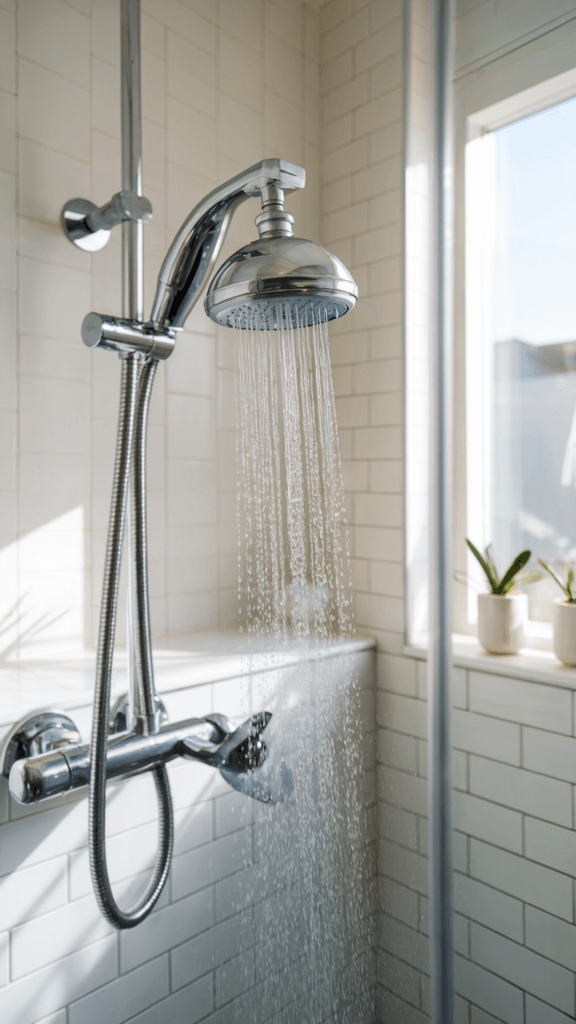
Most people focus on filtering their drinking water, but showering and bathing in unfiltered water can expose your skin and lungs to chlorine, heavy metals, and other contaminants.
When you take a hot shower, steam increases the absorption of these chemicals through the skin and respiratory system, which can contribute to dryness, irritation, and even long-term health effects.
Why Tap Water Contains Contaminants
Municipal water is treated to remove bacteria and pathogens, but in the process, chemicals like chlorine and chloramine are added to disinfect the supply.
Over time, these compounds can strip the skin and hair of natural oils, leading to dryness, irritation, and weakened hair health. Additionally, some water sources contain trace amounts of lead, pesticides, and pharmaceutical residues, making filtration an important step in reducing overall toxin exposure.
Benefits of a Shower Filter
Installing a high-quality shower filter is one of the easiest ways to improve both skin and hair health while minimizing exposure to harmful chemicals. Shower filters work by removing:
- Chlorine and chloramine, reducing dryness and irritation.
- Heavy metals like lead and mercury, which can be absorbed through the skin.
- Other impurities, including some VOCs and synthetic chemicals.
Recommended Shower Filters for a Cleaner Bathing Experience
If you’re looking for an easy, affordable way to filter your shower water, here are some highly-rated options:
Conclusion
Detoxing your bathroom doesn’t have to be overwhelming or expensive. By making a few simple swaps like switching to non-toxic cleaners, choosing safer personal care products, and installing a shower filter, you can significantly reduce your exposure to harmful chemicals while creating a healthier, more natural space.
Start with the changes that feel easiest and build from there. Over time, these small shifts add up, improving both your well-being and your home environment.

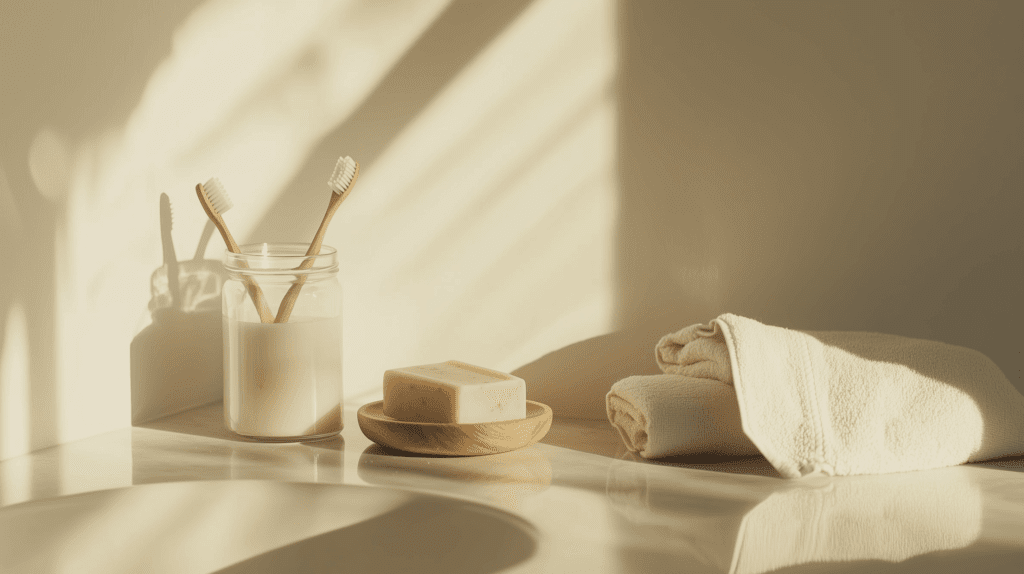




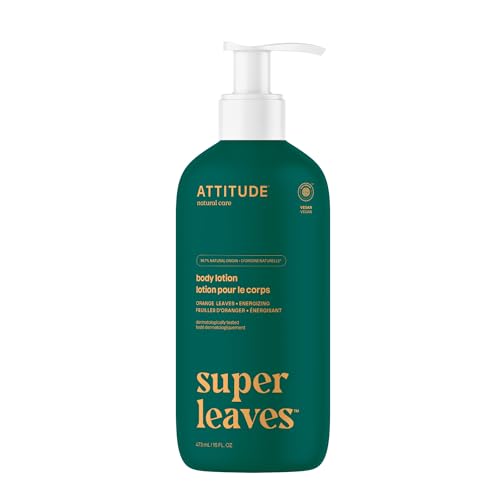

![Bean Products Cotton Stall Shower Curtain (Natural), [70" x 74"] ...](https://m.media-amazon.com/images/I/417-6QsQNSL._SL500_.jpg)






